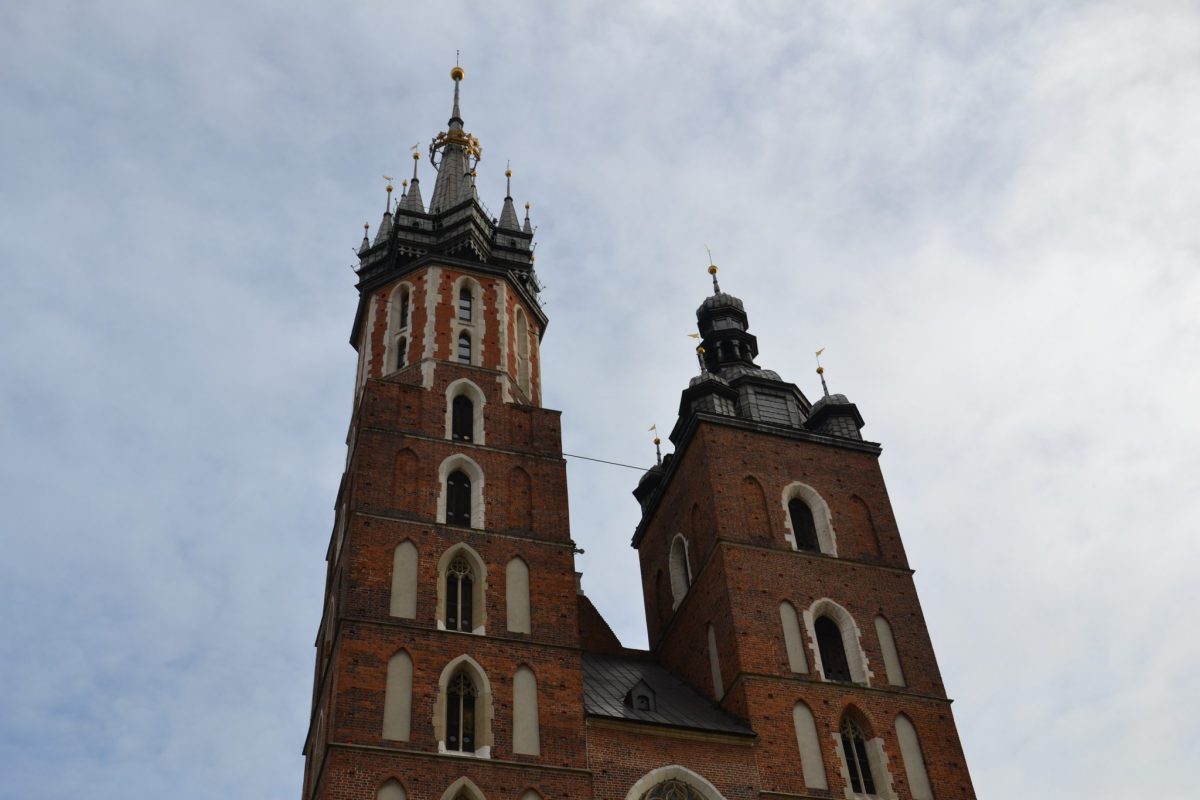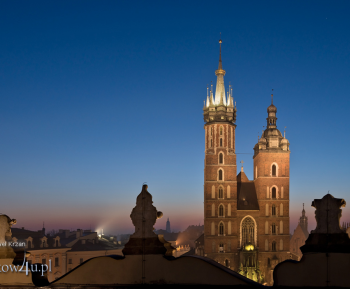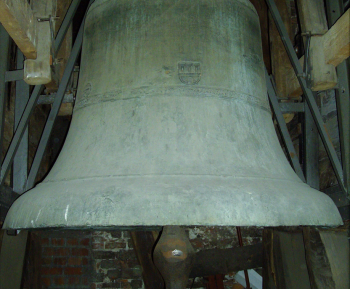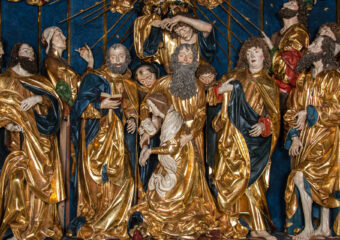Splendid sounds from both towers of St. Mary’s Basilica (the taller 82 meter tower and the shorter 69 meter tower) echo across the entire Kraków. These are the peals of four medieval liturgical bells, strikes of two clock gongs, the sound of the bell for the dying and last but not least, St. Mary’s bugle call, played by a bugler. The St. Mary’s Basilica ensemble of bells and gongs is unique on a world scale. All four liturgical bells (PÓŁZYGMUNT, TENEBRAT, MISJONAŁ AND CAMPANA ANTIQUA – THE OLDEST) are suspended inside the shorter tower which acts as the bell tower.
The clock gongs are sitting high up in the tower steeples. The taller tower is home to a room from which a fireman plays the bugle call every hour. It is located just under the steeple. A „bell for the dying” hangs on the outside wall of the bell tower. Liturgical bells are in regular use. 365 days a year – each one according to a specific schedule. Additional sequences toll during major religious ceremonies (Indulgence for the Assumption of the Blessed Virgin Mary, Paschal Triduum, Corpus Christi procession) as an element of liturgical celebrations. The bells are equipped with electrical (linear) motors, under non-stop operational maintenance supervision performed by RDUCH and the employed bell-ringer. The basilica’s southern wall features a sundial, which in the past dictated the times at which bells and gongs were struck – a continual reminder of the passage of time to all those in the vicinity.
PÓŁZYGMUNT
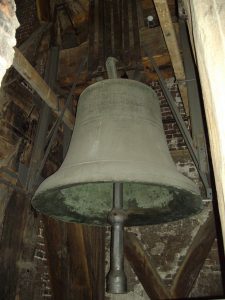
Funded by Polish knights in 1438. It was cast by Jan Freudental a master craftsman. Zbigniew Oleśnicki, a Kraków bishop, later to be ordained as cardinal was the main funder of the bell and its initiator. This is the largest St. Mary’s bell, and in the past, it was the largest bell in Kraków. It is 180 cm in diameter and weighs approx. 4.8 tonnes. It is suspended below the other three bells, on the tower’s fourth storey and rings in C♯1. The bell is dedicated to the Virgin Mary – the basilica’s patron. Her name appears on the inscription a number of times, and an image of Mary with Child figures on its waist next to a plaque with an eagle.
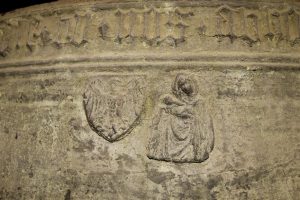
That is where coats of arms of the funders and the Kraków crest can also be found. The king, Władysław III of Poland, has been commemorated on the bell in a special way: his coat of arms (a double cross) appears in two places. A lower part of the bell has been damaged. However, the circumstances surrounding breaking of a section of the sound bow remain unknown. At the moment this bell tolls every day at 9.05 pm and on Fridays at 3.04 pm.
TENEBRAT

Founded by king Władysław II Jagiełło circa 1388. Events of major national and religious significance accompanied its creation. The Polish-Lithuanian union begins in Kreva (in 1385); Jagiełło is baptised, marries Jadwiga and is crowned as the King of Poland (in 1386). Perhaps the royal couple are both responsible for funding the bell. It was cast by a bell maker from Spisz. A pious inscription on the bell’s shoulder bears Christ’s invocation and the words: AVE MARIA. Medallions depicting the symbols of the Four Evangelists are on its waist as well as plaques with Kraków’s and Lithuania’s crest and coats of arms. These are of immense historical value.
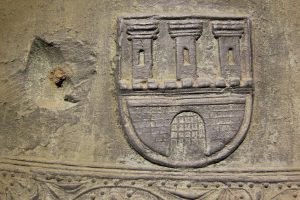
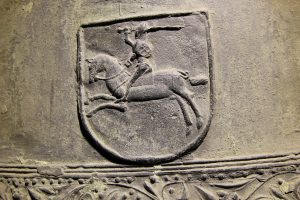
This magnificent bell is 175 cm in diameter and weighs 4.1 tonnes. It was the largest bell in Kraków until the casting of the Knight’s Bell. It hangs on the tower’s 6th storey and rings in C♯1. It’s strike tone sounds on Sundays and public holidays at 9.50 am.
MISJONAŁ

Funded by an unknown funder circa 1387. It was cast by Jan, a Master Craftsman from Nowa Wieś Spiska. It is possible that its name refers to the Christianization of Lithuania but also to the constant need to proclaim the Word of God. One hypothesis claims that Queen Jadwiga, known for her piety, could have contributed to the creation of the bell. The Latin inscription on the bell is a pious call for peace to Christ – The King of Glory. It is 136 cm in diameter and weighs approx. 1.8 tonnes. It hangs on the tower’s 7th storey. It rings in F1. This bell tolls every day at 4 minutes past noon, just after St. Mary’s bugle call.
MIESZCZAŃSKI

This is one of the oldest surviving bells in Poland. It was cast circa 1320 by an unknown master craftsman. St. Mary’s Church was consecrated at the same time following its reconstruction and expansion. This bell could have been funded jointly by the temple’s parishioners and town inhabitants for whom St. Mary’s Church was, and hopefully is, the most sacred temple. Similarly to Misjonał and Tenebrat, the inscription on its waist is a plead for peace to the King of Glory. The sign is in beautiful Latin all caps, only found on the most ancient bells. It is 108 cm in diameter and weighs approx. 0.9 tonnes. It hangs next to Misjonał, on the tower’s 7th storey. It rings in A1. This bell tolls every day at 12.04 pm in a duet with Misjonał.
LARGER CLOCK GONG
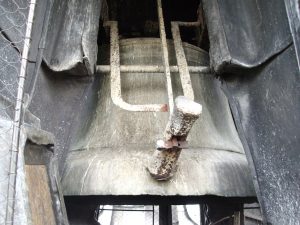
This clock bell dates back to 1530. A fireman strikes it throughout the day on the hour before playing the bugle call. This is done manually, using a device comprising a handle, rod and a lever terminating with a heavy steel hammer which strikes the lower part of the bell’s waist from the outside. The gong is 165 cm in diameter and weighs approximately 3.5 tonnes. It hangs within the taller tower – inside the spire of the Gothic steeple, underneath the gold crown.
SMALLER CLOCK GONG
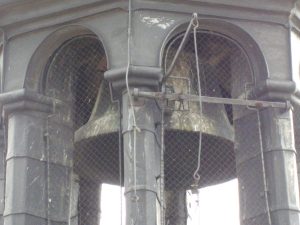
It was made in 1564 and hung inside the steeple of the shorter bell tower. In the past a system of rods and levers linked this bell with the taller tower. A fireman manually repeated full hour strikes on it after playing the bugle call. In 1939 the bell was silenced for 76 years. Today, following a refurbishment, the bell tolls on quarter hours, struck by an electric hammer controlled by an electronic clock. The gong is 140 cm in diameter and weighs approx. 1.7 tonnes.
BELL FOR THE DYING

Cast in 1736 by Kacper Koeber from Wrocław. It bears the name of Archangel Michael – the patron of „good death”. It was funded by Krystian Jungling, a lay judge from Kraków. According to European tradition it rang to announce the death of a parishioner and their birth into heaven. Similar to one of the clock gongs, it was „silent” for the last several dozen years. However, in 2015 it was refurbished and now, once again, it is peals during funeral ceremonies. This is the only active bell of this type in Kraków. This bell’s waist measures 22 cm in diameter and it weighs 7.5 kg. It rings in A♯3.
written by: Andrzej Bochniak
in cooperation with: Piotr Korniak
|
ST. MARY’S BELLS |
|
PÓŁZYGMUNT |
daily, at 9.05 pmFridays, at 3.04 pm |
TENEBRAT |
Sundays and holidays, at 9.50 am |
MISJONAŁ |
daily, at 12.04 pm |
THE OLDEST BELL |
daily, at 12.04 pm |



